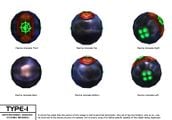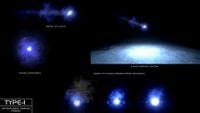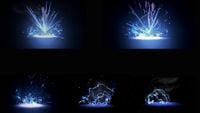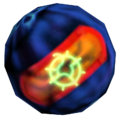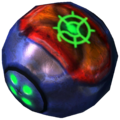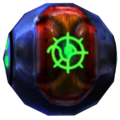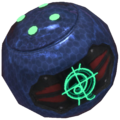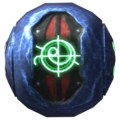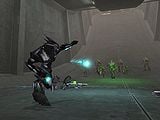Anskum-pattern plasma grenade
From Halopedia, the Halo wiki
- "Holy Flare!"
- — Anonymous Sangheili
The Type-1 Antipersonnel Grenade, more commonly known as the plasma grenade, is a thrown Covenant anti-personnel explosive device.[1] It is analogous to human hand grenades.
Design details
The Type-1 Antipersonnel Grenade is a dangerous hand thrown weapon utilized by Covenant forces, typically used by Unggoy and Sangheili soldiers. The Type-1 Plasma Grenade is a spherical explosive and is made of an unknown material, the grenade in terms of design is straight forward, the activation "switch" is located on the orange colored area of the grenade. Above the activation pad is a Forerunner glyph, the glyphs seen on the Plasma Grenade are known to change with each new model and is believed to be based upon the time of manufacturing and the Covenant religious rituals. Using technology that is barely understood, even by the Covenant, the Type-1 Plasma Grenade is employed as both a thrown anti-infantry and anti-vehicle weapon.
When primed, the Type-1 plasma grenade emits a blue plasma gas, this emission is light so that the grenade does not stick to the person priming the grenade. When thrown, the plasma gas begins to intensify enough that if it comes into contact with a vehicle or infantry, the plasma will start to burn into the surface and adhere to it until detonation. The grenade contains some type of internal mechanism that allows it to distinguish between targets and background, it will stick to a soldier or vehicle, but not to a tree or wall. Once something has been stuck with a grenade, their is no normal way to remove it, only devices like an advanced Electromagnetic shield can temporary disable the internal mechanism, however this technology is rare and only issued to special forces of both the UNSC and Covenant. After sticking to a target, or otherwise coming to a rest a three-second fuse is activated.[2] Detonation is first visible as a flash of white-blue light and the kill zone area is instantly subjected to extreme temperatures, and whatever is in the ground zero area, be it or natural and unnatural formations or otherwise, are instantly vaporized. Because there is no magnetic field to contain the plasma, it begins to cool very quickly - thermal expansion begins to take over and the resulting heat fans outward and upward continuing to burn an area up to forty feet away until the resulting flames have cooled to the point where it cannot continue to expand. After the initial explosion, the kill radius area becomes charged with negative and positive particles which will form electrical currents visible for a short period after the explosion.
The sheer destructive power the plasma grenade deals to any living creature within its vicinity is extreme; when a plasma grenade detonates on, or near a target it is subjected to extreme temperatures, killing anything within a 13 feet radius instantly[3]; damage to the body is extreme, as the heat flash vaporizes the bodies internal fluids and burns flesh and bone to an unrecognizable charred state. The concussion wave released by the grenade will also cause additional damage to anything within the kill radius. Any living being outside of the kill zone may sustain heat damage as well, as non-heat resistant clothing or flammable material may be ignited by the heat released from a detonating plasma grenade. The conclusive force released by the grenade can also harm or disorient anything just outside the kill radius and can also be affected by the flames released from the grenade - a person can also receive injuries from objects being ejected out of the kill zone at high speeds as a result of a plasma grenade detonating.
Advantages
The ability of the Plasma Grenade to stick to its target is extremely useful when encountering moving targets that could easily evade other explosive devices. This adhesive property allows the Plasma Grenade to function as both an anti-infantry and anti-vehicle weapon, where a stuck grenade can take down light vehicles and cause moderate damage to heavier ones. The explosive damage the Plasma Grenade releases is also effective at destroying objects not sensitive to the heat released by one, and can also serve as an effective support weapon as well. Plasma Grenades are also effective at disrupting electronics and shielding when they detonate.[4] The plasma grenade is known to be used by the lesser races of the Covenant as an effective suicidal weapon, a tactic most commonly used by mortally wounded or psychologically unstable Unggoy who will attach primed grenades to their bodies before hurling themselves at their enemies. Against UNSC forces the Plasma Grenade is an effective psychological weapon due to the various consequences the grenade brings to anyone in its path. Its destructive properties can also leave terrible psychological effects on a person who has witnessed one detonate on a fellow soldier and seeing the destructive damage it has done.[5]
Disadvantages
The Plasma Grenade has a three-second fuse that the Human equivalent lacks. Therefore, if the Plasma Grenade does not stick it to the target, the target will have ample time to evade the explosion. Sticking a Plasma Grenade to enemy infantry can be a gamble, as the target stuck with the grenade will have three seconds to chase down the opposite opponent and kill them as well.
History of changes
Changes between Halo: Combat Evolved and Halo 2
- The color of the grenade itself changed from a light blue to a dark blue.
- The explosive effects of the grenade are more detailed.
- The explosion sound effect for the grenade is different and now has more of a subtle hint of a natural explosion.
- The Forerunner glyph on the grenade is different.
- The explosion is less damaging.
- The grenade's fuse timer has been reduced
Changes between Halo 2 and Halo 3 and Halo 3: ODST
- The color of the gas and explosion are now dark blue and the grenade's explosive effect is much brighter and more detailed.
- The model for the plasma grenade is now much more detailed and the Forerunner glyph is different.
- The grenade now emits a high pitched noise when sticking and preparing to detonate.
- Will sometimes stick to a wall.
Changes between Halo 3, Halo 3: ODST and Halo: Reach
- The holographic Forerunner glyph on the casing is different.
- The grenade is more detailed, featuring four triangular red "buttons."
Tactics
Campaign
- Whenever a Zealot wielding an energy sword approaches, he will pause, scream and shake around before he attacks. That's the best time to stick him with a plasma grenade
- When you throw two or more plasma grenades into one tight-knit area, the first grenade's explosion can cause the other grenade to launch in any direction then detonate. Use this skillfully to take down an enemy's shield or score a lucky kill.
- Elites will dive away from grenades. Even when on bridges or high ledges. Grunts will seek the comfort of their companions when a plasma grenade is stuck to them. This is effective at maximizing casualties against the Grunts' commander.
- Whereas the frag grenade will explode roughly one second after coming to rest, the plasma grenade takes about three seconds. The grenade's bounce is considerably less than the frag grenade's, as well. Keep this in mind when timing your throws so your target can't rush past the grenade.
- Some high ranking Covenant commanders cannot be stuck, such as Brute Chieftains, as their armor cannot be stuck by Plasma and Spike Grenades. However, their weapon can still be stuck, which usually results in an immediate kill. Once their helmet is knocked off, you can stick a plasma grenade to the exposed area of the Brute.
- Like all grenades, it can be cooked by a weapon. This can be an effective trap if you are able to successfully bait your enemy.
- If you stick an Elite or a Brute they will either charge you in an attempt to take you out, or take cover to protect their allies. Sometimes, if an Elite is stuck on the chest in Halo: CE, he may flail his arms in an attempt to take off the grenade then begin to run away and scream.
- By making an enemy Grunt stagger or shift while throwing a Plasma Grenade it can cause the Grunt to stick his comrades by accident, due to Grunt standard operating procedure of fighting in groups. This increases the possibility of the grenade killing the thrower, if not his comrades. Another way of using this tactic to your advantage is to injure the Grunt right as he throws the grenade. This will cause him to drop it on the ground and get killed by the explosion.
Multiplayer
- The Plasma Grenade is one of the most helpful grenades in the game. It is advised to not waste it on a weak or unimportant target. It is recommended to use it against vehicles, as its blast can flip a Mongoose.
- In Halo 3, the Plasma Grenade can be slammed away by the effects of a Gravity Hammer, but the force of the hammer may cause grenades to detonate immediately. This makes this tactic risky.
- Players have been known to somehow "remove the sticky" and throw it back, but on closer inspection you will notice that it only works if you stick your hand, then throw a grenade or a piece of Equipment.
- In some cases a player can throw a Plasma Grenade onto a Power Drain and let it roll inside a Bubble Shield. The Plasma Grenade will pass inside the shield and detonate killing anyone unaware of what has happened.
- In a Forge game, after getting stuck as a Sangheili/Spartan, turning into monitor mode will cause the grenade to not detonate. But if you turn back into Sangheili/Spartan, the grenade will explode and can serve as an effective suicide bomb.
- If you see a team of two near each other, throwing a Plasma Grenade on one Spartan can wipe out the other man, since the Plasma Grenade has a wide blast radius.
- If a player's weapon is stuck with a Plasma Grenade, it is possible to pick up another weapon, thereby dropping the "stuck" weapon, and live. The Plasma Grenade will stay on the dropped weapon and still explode, though not be considered a stick. Switching for your secondary weapon won't help, since you still carry the "stuck" weapon.
Trivia
- It is difficult but possible to stick another grenade while it is in the air, effectively stopping and detonating both.
- Although they do not stick to regular surfaces, Plasma Grenades will appear to sink into the ground after bouncing off of a surface.
- In Halo: Combat Evolved, the plasma grenade has the same throwing noise as the UNSC frag grenade.
- In the Halo 2 video "Another Day at the Beach", Gunnery Sergeant Stacker is stuck with a Plasma Grenade on his ODST helmet, but saves himself by throwing away the helmet.
- It is possible to create a makeshift grenade launcher in Halo: Combat Evolved using two Plasma Grenades. To do this, one should throw a Plasma Grenade at the ground from a safe distance. When it hits the ground, wait a few seconds and then throw the other Plasma Grenade in front of it. If timed right, the blast from the first grenade will launch the other grenade across the map.
- If one sticks a player with a Plasma Grenade with an overshield and kill them, one will not receive a stick medal. However, using a Spike Grenade will do so.
- In Halo 3, Halo 3: ODST, and Halo: Reach, Unggoy will sometimes arm two Plasma Grenades and run towards the player, becoming suicide bombers. This feature is prominent on the level Exodus in Halo: Reach.
- Like the Firebomb grenade and Spike Grenade, If a Flood Carrier Form is stick by a Plasma Grenade, it will not release any Infection forms.
Gallery
- 1220831252 Plasma nade.png
The Plasma Grenade as seen in Halo: Combat Evolved.
- HaloCE-PlasmaGrenade-transparent.png
An in-game view of the Plasma Grenade in Halo: Combat Evolved.
- Suicide Grunt.jpg
A Suicide Grunt charging at his foes.
A Sangheili throws a Plasma Grenade at oncoming Flood in Halo: Combat Evolved.
- Medal 014.gif
The medal that appears when you stick someone in multiplayer.
- Plasmaexplosion.jpg
A plasma grenade explosion in Halo 4.
List of appearances
- Halo: The Fall of Reach (First appearance)
- Halo: Combat Evolved
- Halo: The Flood
- Halo: First Strike
- Halo 2
- Halo Graphic Novel
- Halo: Ghosts of Onyx
- Halo: Uprising
- Halo 3
- Halo: Contact Harvest
- Halo Wars
- Halo: Helljumper
- Halo 3: ODST
- Halo Legends
- Halo: Reach
- Halo 4
Sources
- ^ Halo Encyclopedia, "chapter 11", page 332
- ^ Halo: Combat Evolved, Game Manual, page 21
- ^ Halo: Ghosts of Onyx, "chapter 39", page 359
- ^ Halo: First Strike, "chapter 7", page 69
- ^ Halo: The Flood, "chapter 2", page 67

